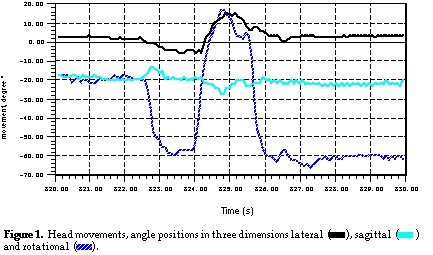
Measurement and analysis of head movement behavior during conversation
A. Altorfer1, S. Jossen1, M.L. Käsermann1, N. Foppa2 and H. Zimmermann1
1 Department of Theoretical and Evaluative Psychiatry,
Psychiatric Institutions University of Berne, Berne, Switzerland
2 Institute of Psychology, University of Berne, Berne, Switzerland
To date, two different methodological approaches have been used to collect data on nonverbal behavior in conversation. On the one hand, interpretative methods involve raters having to identify a set of previously defined categories of behavior and to code the intensity of these behavioral manifestations using extensive coding manuals. On the other hand, transcriptions of behavior which contain detailed classifications of body movements use accurate procedures - e.g. picture-by-picture evaluations of videotapes - to deal with the complexity of behavioral manifestations.
In the present contribution, exact behavioral transcriptions of head movements are regarded as a prerequisite for investigating the function and meaning of nonverbal behavior. Additionally, a coordination of behavioral recording and analysis to verbal interaction and psychophysiological measurement is required which includes a time-related matching of all data channels in the range of milliseconds. In this respect, a method is developed which allows directly collecting data on head movements by using small ultrasonic transducers (buttons) which are attached to the head and the shoulders of an index person. The transducers are called up in the same order (in series), whereby positions are received every 40 ms. A microcomputer determines receiver-transducer distances and calculates three-dimensional positions by triangulation as a function of time, over a data-collection situation of variable length. Based on these data, evaluations are made which calculate angle-positions of the head (in rotation, lateral and sagittal dimensions), movement changes of the head (direction and size in rotational, lateral and sagittal dimensions), and intensities of head movements (cp. Figure 1). Further steps of the analysis present procedures to determine relevant changes in movements, to identify segments of movements, and to classify the quantifications of head movements according to the similarity of movement patterns.

The measured patterns of nonverbal behavior can be accurately related to different features of the situational context (cp. verbal communication, vocal communication, cardiovascular activity [1]). The automated transcription and classification of movement patterns even allows the exploration of nonverbal behavior which still lacks descriptive identification. To estimate possible meanings of behavioral patterns, a heuristic is proposed which includes the situational context as the basis of interpretation (i.e. situations surrounding nonverbal behavior, e.g. verbal behavior in conversations).

Poster presented at Measuring Behavior '98, 2nd International Conference on Methods and Techniques in Behavioral Research, 18-21 August 1998, Groningen, The Netherlands